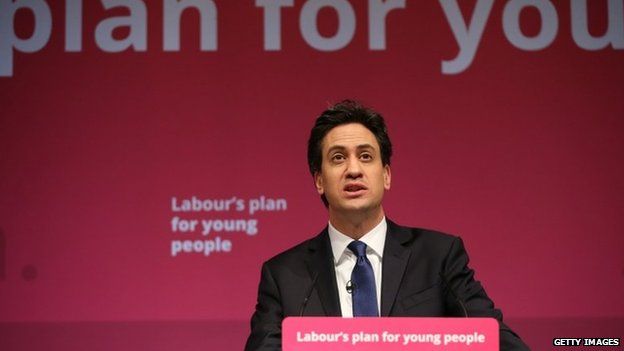How Labour pays for student fee cut
- Published
- comments

Here is how Ed Miliband is trying to answer some of the questions I raised about who will benefit from his cut in student fees and how this cut will be financed.
Labour will try to make sure that graduates who get the highest paid jobs don't disproportionately benefit from the cut in fees and associated debt from £9,000 to £6,000 by putting up the interest rate on student debt by an unspecified amount for higher earners - to raise £200m a year.
And a Labour government would also increase the maintenance grant for poorer students from £3,400 to £3,800.
The shadow chancellor Ed Balls and his team estimate that the cost of the cutting the fee cap to £6,000 will be £3.1bn.
That, Labour says, will be covered by the £200m from raising the interest rate on more prosperous graduates and £2.9bn to be raised from a tax raid on pensions.
The pensions raid would have three elements.
Those earning £150,000 a year will have their relief on pension saving capped at 20% - which is quite a chunky disguised tax increase for those on higher earnings.
Also the lifetime limit on the size of pension pots would be reduced from £1.25m to £1m, and annual maximum contributions to pension pots will be cut from £40,000 to £30,000.
Now some will immediately accuse Labour of using some of this revenue twice, since the tax-relief cap for top earners was already supposed to be financing the £500m annual costs of a jobs guarantee and apprenticeships.
But the £500m annual cost of those measures will apparently now be covered by a putative corporation tax surplus "after cutting and freezing business rates".
Labour will also claim that in cutting tuition fees, it will reduce the national debt, by £13bn in the next parliament and £40bn by 2030.
Update 13:20
I now understand Labour's £500m corporation tax "surplus" - which I referred to earlier as paying for the apprenticeships and jobs guarantee.
That is the difference between what Labour saves from not going ahead with this government's planned 1p in the pound cut in the main rate of corporation tax and what it will spend on freezing business rates for smaller businesses.
Update 16.35
One way of seeing Labour's tuition fee plan is that it is replacing £3.1bn of university financing via student loans with £3.1bn of financing from taxation - through a tax raid on pensions.
But this doesn't mean that tax payers will be £3.1bn a year poorer in the long term relative to the existing debt-funded scheme
Because something like half of all the student debt will never be repaid, according to the government's own accounting
Which means that to an extent the difference between paying through taxation and paying with debt is simply a choice about when the burden falls on the state.
What is unclear is how many people will be affected by the tax reforms - because authoritative data does not appear to exist.
That said the proposed new ceiling on total pension pots of £1m - which would yield a pension of around £30,000 a year - would constrain the pensions of many people - from senior teachers to policemen - who would not remotely be regarded as super rich.
What's more the new limit on annual pension saving of £30,000, down from £40,000. would make it very difficult for savers starting now to accumulate a pot of that size.
One important way of seeing how tax breaks for pensions have been savaged since the 2008 crash is that as recently as 2010 it was possible to save £255,000 in a pension pot every year
So the pension changes will be seen as hurting the middle middle class - though maybe they'll be chuffed that the debt burden on their student children will be cut.